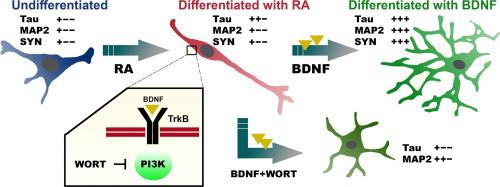当前位置:
X-MOL 学术
›
BBA Mol. Cell Res.
›
论文详情
Our official English website, www.x-mol.net, welcomes your
feedback! (Note: you will need to create a separate account there.)
Brain-derived neurotrophic factor (BDNF) promotes molecular polarization and differentiation of immature neuroblastoma cells into definitive neurons.
Biochimica et Biophysica Acta (BBA) - Molecular Cell Research ( IF 4.6 ) Pub Date : 2020-05-08 , DOI: 10.1016/j.bbamcr.2020.118737 Lenka Hromadkova 1 , Dagmar Bezdekova 2 , Jan Pala 2 , Sophia Schedin-Weiss 3 , Lars O Tjernberg 3 , Cyril Hoschl 4 , Saak V Ovsepian 4
Biochimica et Biophysica Acta (BBA) - Molecular Cell Research ( IF 4.6 ) Pub Date : 2020-05-08 , DOI: 10.1016/j.bbamcr.2020.118737 Lenka Hromadkova 1 , Dagmar Bezdekova 2 , Jan Pala 2 , Sophia Schedin-Weiss 3 , Lars O Tjernberg 3 , Cyril Hoschl 4 , Saak V Ovsepian 4
Affiliation

|
Throughout development, neuronal progenitors undergo complex transformation into polarized nerve cells, warranting the directional flow of information in a neural grid. The majority of neuronal polarization studies have been carried out on rodent-derived precursor cells, programmed to develop into neurons. Unlike these rodent neuronal cells, SH-SY5Y cells derived from human bone marrow present a sub-clone of neuroblastoma line, with transformation into neuron-like cells showing a range of highly instructive neurobiological characteristics. We applied two-step retinoic acid (RA) and brain-derived neurotrophic factor (BDNF) protocol to monitor the conversion of undifferentiated SH-SY5Y cells into neuron-like cells with distinctly polarized axon-dendritic morphology and formation of bona fide synaptic connections. We show that BDNF is a key driver and regulator of the expression of axonal marker tau and dendritic microtubule-associated protein-2 (MAP2), with their sorting to distinct cellular compartments. Using selective kinase inhibitors downregulating BDNF-TrkB signaling, we show that constitutive activation of TrkB receptor is essential for the maintenance of established polarization of SH-SY5Y cells. Importantly, the proximity ligation assay applied in our preparation demonstrates that differentiating neuron-like cells develop elaborate synaptic connections enriched with hallmark pre- and postsynaptic proteins. Described herein observations highlight several fundamental processes related to neuronal polarization and synaptogenesis in human-derived cells, which are of major relevance to neuronal biology, neurodevelopment, and translational neuroscience.
中文翻译:

脑源性神经营养因子(BDNF)促进未成熟神经母细胞瘤细胞分化为定型神经元的分子极化和分化。
在整个发育过程中,神经元祖细胞经历复杂的转化为极化的神经细胞,从而保证了信息在神经网格中的定向流动。大多数神经元极化研究已在啮齿类动物衍生的前体细胞上进行,并被编程发展为神经元。与这些啮齿动物神经元细胞不同,源自人骨髓的SH-SY5Y细胞呈现成神经母细胞瘤细胞系的亚克隆,并转化为神经元样细胞,表现出一系列高度指导性的神经生物学特征。我们应用了两步视黄酸(RA)和脑源性神经营养因子(BDNF)协议来监控未分化的SH-SY5Y细胞向神经元样细胞的转化,该细胞具有明显极化的轴突-树突形态并形成了真正的突触连接。我们显示,BDNF是轴突标记tau和树突状微管相关蛋白2(MAP2)的表达的关键驱动器和调节剂,它们分别排列到不同的细胞区室。使用选择性下调BDNF-TrkB信号的激酶抑制剂,我们表明TrkB受体的组成性激活对于维持SH-SY5Y细胞极化的建立至关重要。重要的是,在我们的制剂中应用的邻近连接测定法表明,分化神经元样细胞会形成复杂的突触连接,并富含标志性突触前和突触后蛋白。本文所述的观察结果突出了与人类衍生细胞中神经元极化和突触发生有关的几个基本过程,这些过程与神经元生物学,神经发育和转化神经科学具有重大关系。
更新日期:2020-05-08
中文翻译:

脑源性神经营养因子(BDNF)促进未成熟神经母细胞瘤细胞分化为定型神经元的分子极化和分化。
在整个发育过程中,神经元祖细胞经历复杂的转化为极化的神经细胞,从而保证了信息在神经网格中的定向流动。大多数神经元极化研究已在啮齿类动物衍生的前体细胞上进行,并被编程发展为神经元。与这些啮齿动物神经元细胞不同,源自人骨髓的SH-SY5Y细胞呈现成神经母细胞瘤细胞系的亚克隆,并转化为神经元样细胞,表现出一系列高度指导性的神经生物学特征。我们应用了两步视黄酸(RA)和脑源性神经营养因子(BDNF)协议来监控未分化的SH-SY5Y细胞向神经元样细胞的转化,该细胞具有明显极化的轴突-树突形态并形成了真正的突触连接。我们显示,BDNF是轴突标记tau和树突状微管相关蛋白2(MAP2)的表达的关键驱动器和调节剂,它们分别排列到不同的细胞区室。使用选择性下调BDNF-TrkB信号的激酶抑制剂,我们表明TrkB受体的组成性激活对于维持SH-SY5Y细胞极化的建立至关重要。重要的是,在我们的制剂中应用的邻近连接测定法表明,分化神经元样细胞会形成复杂的突触连接,并富含标志性突触前和突触后蛋白。本文所述的观察结果突出了与人类衍生细胞中神经元极化和突触发生有关的几个基本过程,这些过程与神经元生物学,神经发育和转化神经科学具有重大关系。











































 京公网安备 11010802027423号
京公网安备 11010802027423号